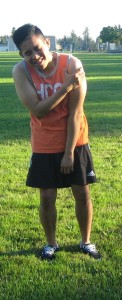A rotator cuff tear is an injury that occurs when the tendons of the muscles in the shoulder is torn. Repetitive stress on the shoulder muscles incites inflammation and the formation of microruptures that may eventually lead to a full tear. Moreover, the bursa in the shoulder, which is a lubricating sac that allows free movement of the arm, may also be inflamed which contributes to the pain experienced and the limited range of motion of the shoulder.
The shoulder muscle is actually composed of 4 muscles that form a cuff, hence the term rotator cuff, that stabilizes the upper arm bone, or the humerus, as it moves within the socket of the shoulder joint. These muscles are the following: the supraspinatus, infraspinatus, subscapularis and the teres minor muscles. Injury to one of these muscles, most commonly the supraspinatus muscle, is caused by the degenerative changes brought about by aging or the wear and tear of the muscle from the repetitive use of the shoulder. This can be seen in athletes such as baseball pitchers, rowers or swimmers and even in professions that involve a lot of overhead movement such as painters or carpenters. An acute injury that is caused by blunt force trauma on the shoulder such as a fall can also cause this injury. Another cause may be the presence of bone spurs on the shoulder.
A rotator cuff tear is a common injury that afflicts around 2 million people in the United States of America alone. Due to the degenerative nature of the injury, the incidence increases as you age with most cases occurring in people over the age of 40.
To learn how to apply first aid on a rotator cuff tear and other soft tissue injuries, enroll in First Aid Classes.
Classification of a Rotator Cuff Tear
Classifying the type of rotator cuff tear usually depends on the severity of the injury and the muscles involved. The following is the most common classification:
- Partial thickness tear – there is damage on the shoulder but does not completely sever the tendon of the shoulder muscles
- Full thickness tear – this is a more severe injury wherein there is a complete tendon tear
Signs and Symptoms of a Rotator Cuff Tear
A rotator cuff tear usually presents with pain especially upon movement of the shoulder. Other signs and symptoms of a rotator cuff tear are the following:

- Pain that may persist with inactivity, rest or even sleeping at night most especially if lying on the injured shoulder
- Pain when resistance is applied or when lifting or moving an object
- Weakness of the shoulder upon movement or rotating it
- Crackling sound when moving the shoulder
First Aid Treatment of a Rotator Cuff Tear
Foregoing early treatment and first aid to a rotator cuff tear may lead to more serious injuries, as the tear can get larger and more painful over time. The following are some non-surgical treatment options:
- Rest – limiting the activities that involve the overhead movement of the shoulder for a prolonged period of time may be beneficial for the patient. A sling may also be recommended to immobilize the shoulder
- Non steroidal anti-inflammatory medications such as ibuprofen or aspirin may help lessen the pain and swelling
- Strengthening exercises and physical therapy may be done to restore full range of motion, mobility, flexibility and strength of the shoulder
- Steroid injection such as cortisone may help relieve pain and swelling
If symptoms persist for more than 6 months, more invasive procedures such as surgical repair of the shoulder via arthroscopic repair or open tendon repair may be recommended. A large tear that is more than 3 centimeters is another indication.
A rotator cuff tear is a painful and in more severe cases, disabling injury,that is caused when a tear in the tendons of the muscles in the shoulder develop.
